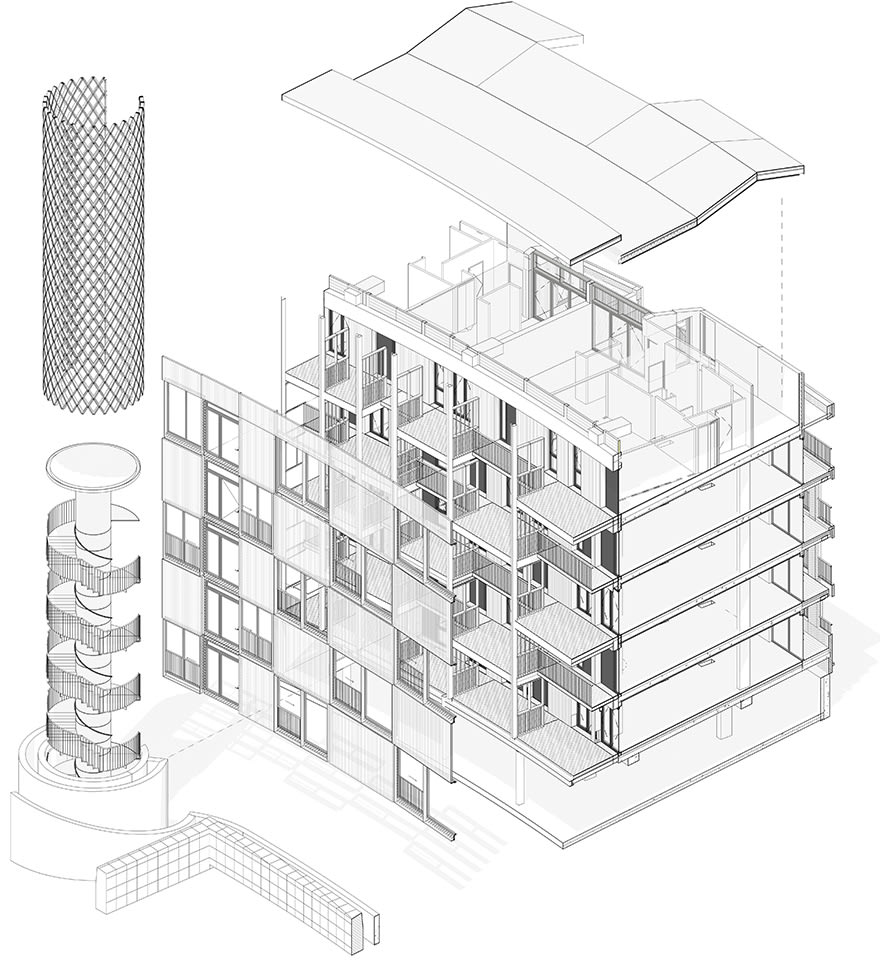- Client: PegasusLife
- Lead Contractor: Midas Group
- BIM Tools: Autodesk Revit
Designed for retirement home operator PegasusLife, this £8m development in Hortsley, East Sussex includes 38 dual-aspect apartments, each designed to be highly adaptable to suit the specific needs of occupants.
The challenge of how to combat loneliness was a fundamental driver for the design and all spaces aim to encourage social interaction and foster a sense of community.
A gallery access arrangement along the south facade provides shared, double-height balcony spaces within the circulation zone, effectively increasing the number of immediate neighbours from two to six. The balconies overlook a 3.5m-wide winter garden.
The use of BIM was driven by architect RCKa, with the project being its first carried out in Revit. The entire scheme was designed and delivered using the software, including outline design, planning drawings, tender information, employer’s requirements and construction.
As a fledgling BIM user, coordination was managed offline, by RCKa, importing drawing data from consultants, including structural engineer, Symmetry, and M&E consultant, Max Fordham, into its own central model.
Revit helped streamline development of the original concept and quickly test out the impact different configurations on the scheme’s economic viability.

The model formed the basis of the planning application
Russell Curtis, director at RCKa told BIM+: “Revit is able to generate schedules of areas, almost in real time. We could change an apartment from one to two beds, or move an internal partition and it would immediately tell us the impact on values. It was much faster than our previous method of drawing in 2D in CAD then inputting the data into spreadsheets.”
The model formed the basis of the planning application and helped establish key technical aspects of the scheme, so that the project team could be confident, post-planning, that it would be buildable.
The innovative access gallery space, with its interconnected balconies, required a highly bespoke fire engineering design. Revit was utilised by Max Fordham to develop a computational fluid dynamics model of smoke extraction. In addition, the firm used it to perform SAP calculations for individual dwellings and heat gain calculations for the winter garden space.
Curtis comments: “The winter garden is such an important space, we had to undertake this technical analysis at an early stage to ensure the scheme we submitted for planning worked environmentally. This would not have been possible if we were drawing in two dimensions.”
Other benefits included Revit’s ability to output 3D visualisations to help explain the principles of the design to the client and other stakeholders.
However, in some areas the software failed to meet requirements. Planning drawings and construction details exported from the model required a large amount of post-production work, to correct line weights and de-clutter images, to make them attractive and legible.
As a relative novice, RCKa sometimes found the software complicated and unwieldy. “On a small project like this you don’t want to have to model every single junction, only the typical ones, the rest can remain as 2D drawings, but we found it difficult to determine the amount of 3D geometric information to include. We have still to find right balance between what we model and what we draw,” he says.
A decision was made not to carry out any clash detection, partly due to the small scale of the scheme, partly due to the belief it is unnecessary if a design has been properly thought through with sufficient space allocated in risers or service voids etc.
Overall, this testbed implementation of Revit was considered a success and next year RCKa plans to transfer the entire practice onto the platform for use on every project.
We could change an apartment from one to two beds, or move an internal partition and it would immediately tell us the impact on values. It was much faster than our previous method of drawing in 2D in CAD then inputting the data into spreadsheets.– Russell Curtis, RCKa











